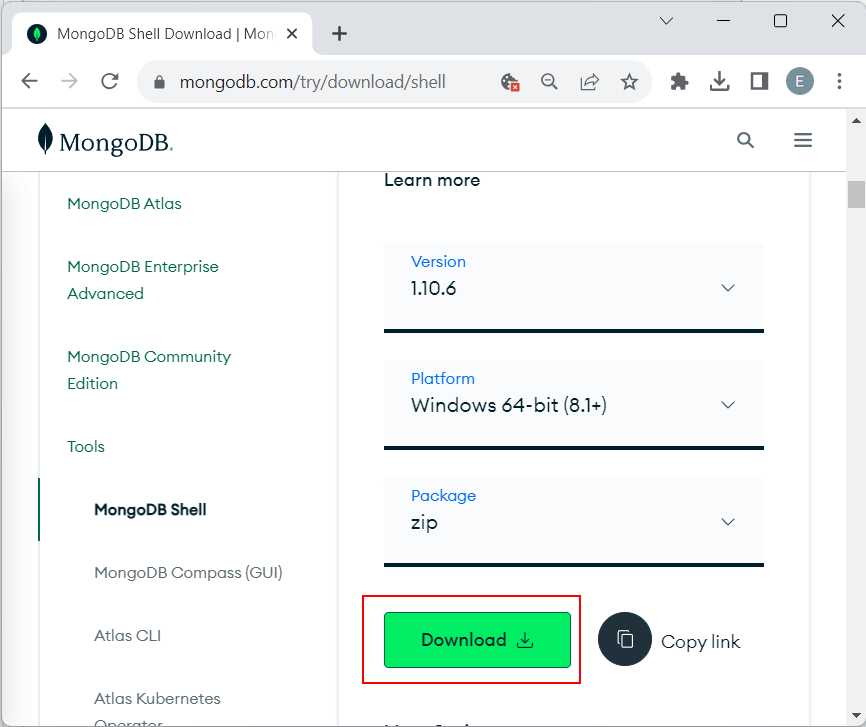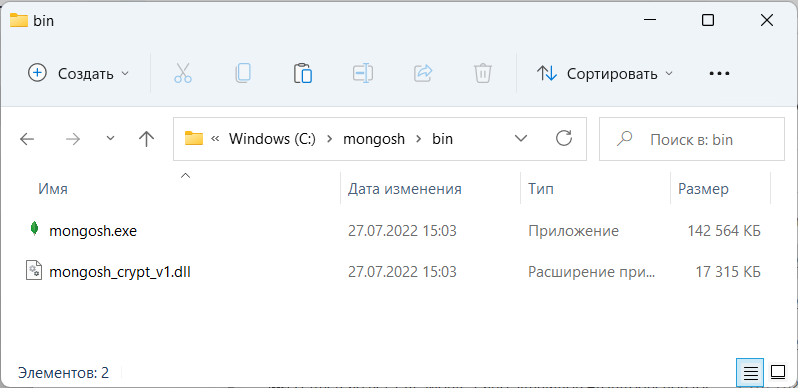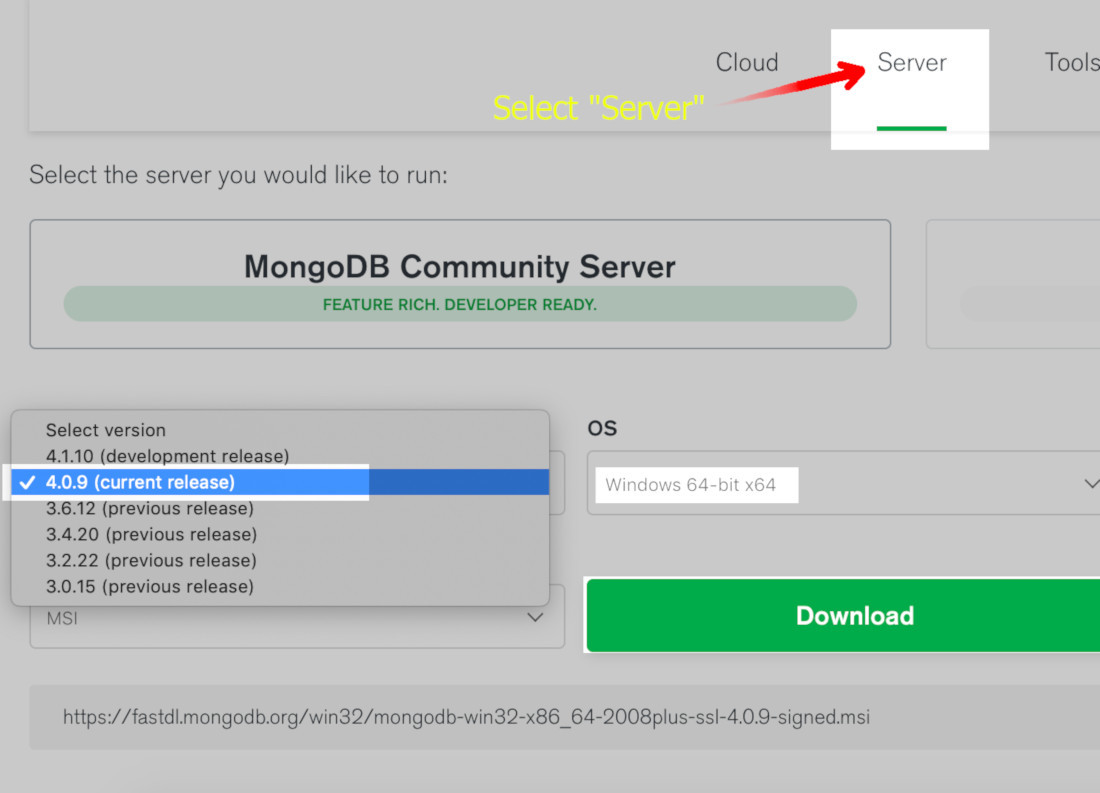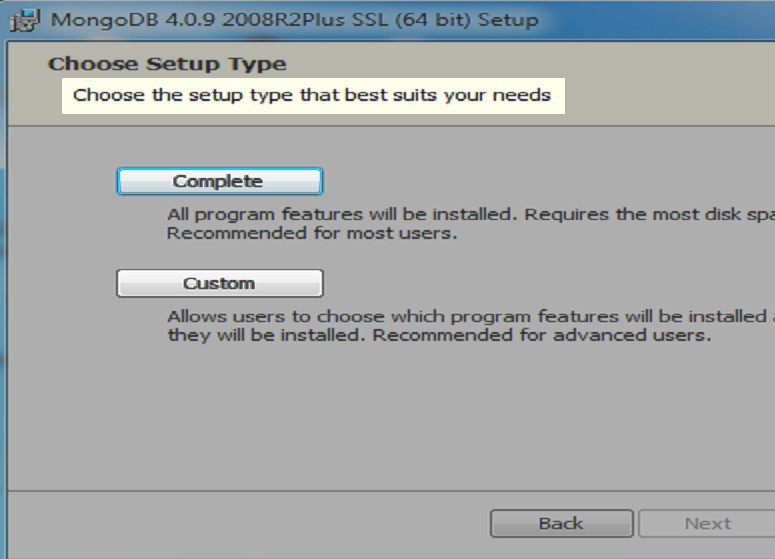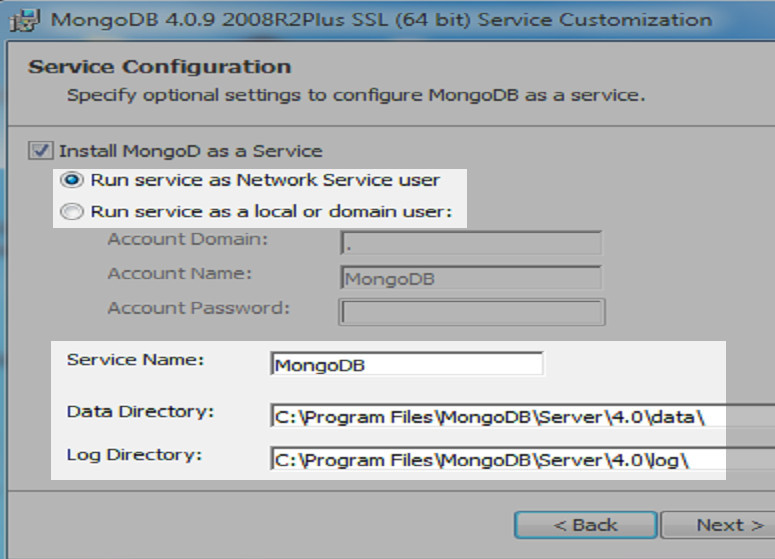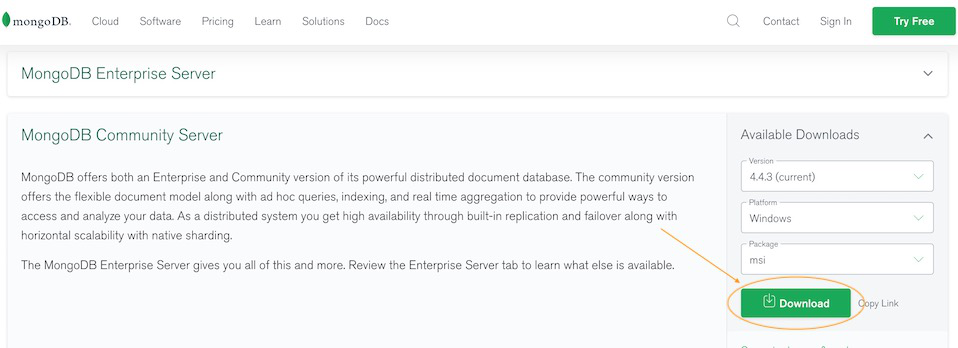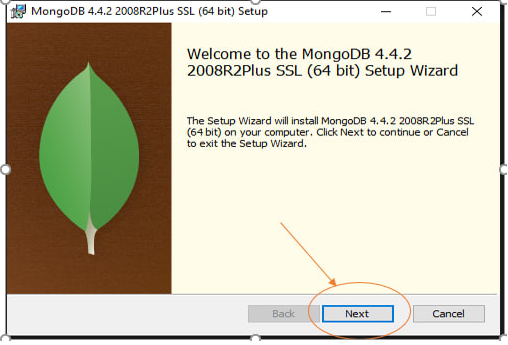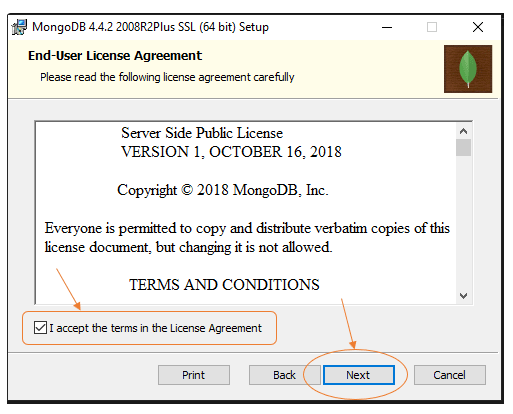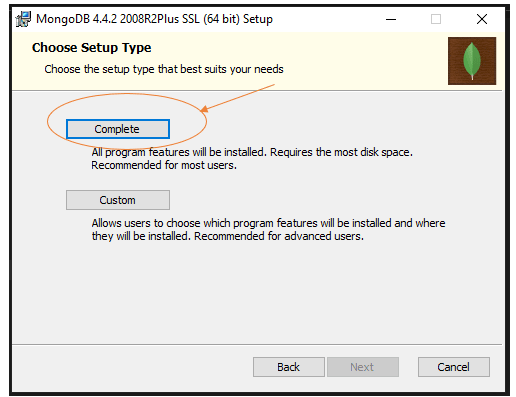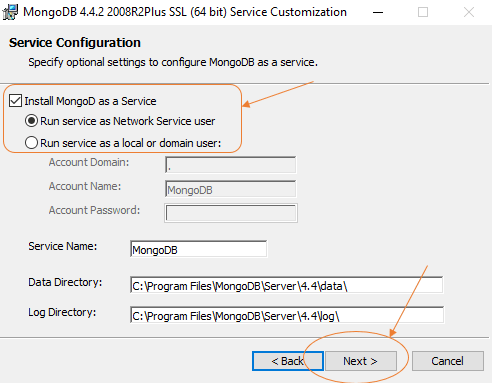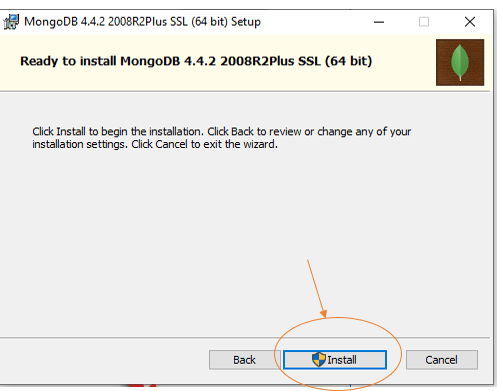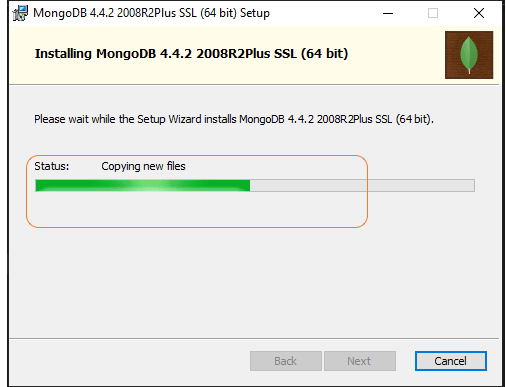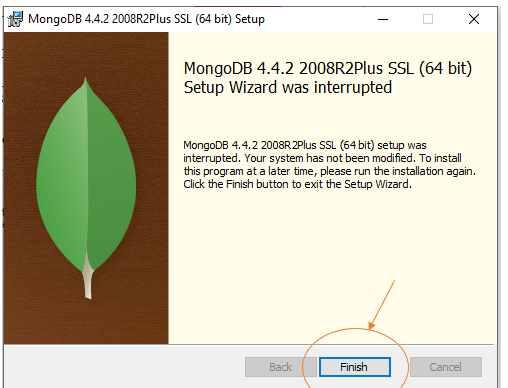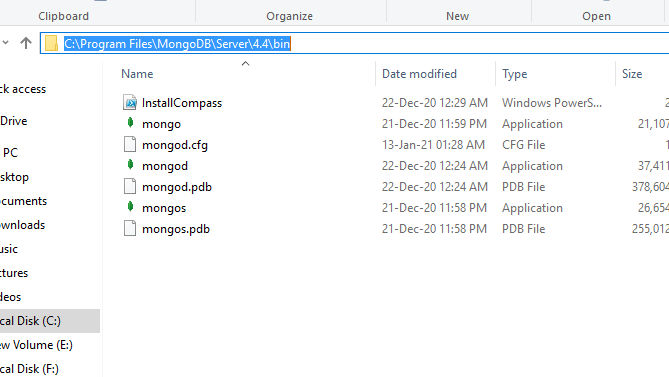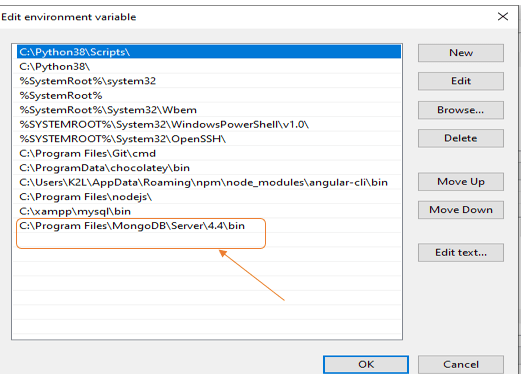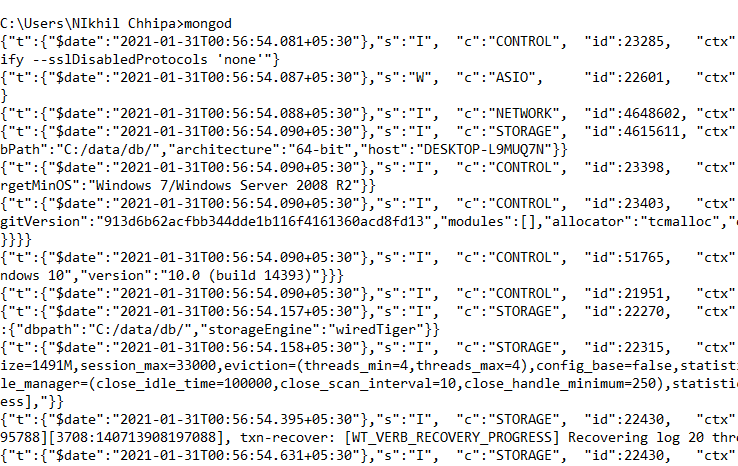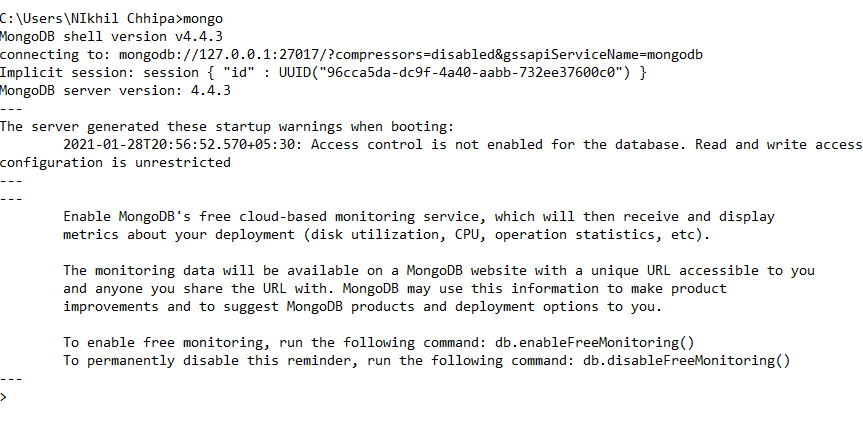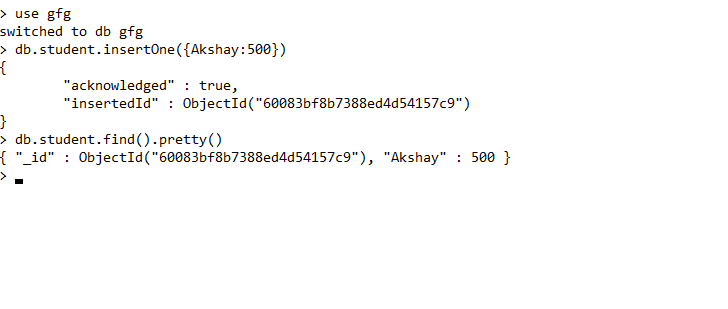Последнее обновление: 07.09.2023
Установка сервера Mongod
Официальный сайт предоставляет пакеты дистрибутивов для различных платформ: Windows, Linux, MacOS, Solaris. И каждой платформы доступно несколько дистрибутивов.
Причем есть два вида серверов — бесплатный Community и платный Enterprise. В данном руководстве будем использовать бесплатную версию Community.
Для установки MongoDB загрузим один распространяемых пакетов с официального сайта https://www.mongodb.com/try/download/community.
Для загрузки всех необходимых файлов выберем нужную операционную систему и подходящий тип пакета. Рассмотрим на примере установки на ОС Windows.
MongoDB можно загрузить в ряде вариантов. Так, для Windows доступна загрузка установщика msi и также доступна загрузка архива zip.
В реальности нам достаточно загрузить zip-архив и распаковать в нужной нам папке. Поэтому выберем этот вариант загрузки (хотя также можно выбрать вариант установщика msi):
Если до установки уже была установлена более ранняя версия MongoDB, то ее необходимо удалить.
После загрузки архивного пакета распакуем его в папку C:\mongodb.
Если после установки мы откроем папку bin в распакованном архиве (C:\mongodb\bin), то сможем найти там кучу приложений, которые выполняют определенную роль. Вкратце рассмотрим их.
-
mongod: сервер баз данных MongoDB. Он обрабатывает запросы, управляет форматом данных и выполняет различные
операции в фоновом режиме по управлению базами данных -
mongos: служба маршрутизации MongoDB, которая помогает обрабатывать запросы и определять местоположение данных в кластере
MongoDB
Создание каталога для БД и запуск MongoDB
После установки надо создать на жестком диске каталог, в котором будут находиться базы данных MongoDB.
В ОС Windows по умолчанию MongoDB хранит базы данных по пути C:\data\db, поэтому, если вы используете Windows, вам надо создать
соответствующий каталог.
Если же возникла необходимость использовать какой-то другой путь к файлам, то его можно передать при запуске MongoDB во флаге
--dbpath.
Итак, после создания каталога для хранения БД можно запустить сервер MongoDB. Сервер представляет приложение mongod, которое находится
в каталоге bin в папке сервера. Для этого запустим терминал/командную строку и там введем соответствующие команды. Для ОС Windows это
будет выглядеть так:
Командная строка отобразит нам ряд служебной информации, например, что сервер запускается на localhost на порту 27017.
И после удачного запуска сервера мы сможем производить операции с бд через клиент.
Установка клиента Mongosh
Выше мы установили сервер MongoDb. Однако для работы с сервером нам нужен клиент. Наиболее простым клиентом в данном случае является MongoDB Shell или mongosh —
консольная оболочка для отправки запросов к серверу, которая также предоставляется непосредственно компанией MongoDB.
Для установки клиента перейдем по адресу https://www.mongodb.com/try/download/shell
Здесь опять же мы можем выбрать версии клиента для разных операционных систем. Для Windows пакет клиента доступен в виде архива zip.
Загрузим этот пакет и распакуем его в папку C:\mongosh.
Если в распакованном архиве мы зайдем в папку bin (то есть C:\mongosh\bin), то обнаружим там консольную утилиту mongosh,
которая будет применяться для работы с сервером MongoDB:
Подключение к серверу из клиента
Используем выше установленное клиентское приложение mongosh для взаимодействия с сервером mongodb. (При работе с mongosh не стоит забывать, что у нас должен быть запущен сервер mongod).
Итак, запустим файл mongosh, который располагается в выше рассмотренной папке установки:
При запуске программы mongosh вначале она спросит пользователя, какую строку подключения использовать для подключения к серверу MongoDB. В этом моменте просто нажмем на Enter,
чтобы использовать строку подключения к MongoDB по умолчанию. А по умолчанию сервер mongodb запускается на порту 27017,
а полная строка подключения выглядит следующим образом: mongodb://localhost:27017 или mongodb://127.0.0.1:27017
После подключения консоль отобразит ряд служебной информации и подключится к базе данных test.
Теперь поизведем какие-либо простейшие действия. Введем в консоль последовательно следующие команды и после каждой команды нажмем на Enter:
db.users.insertOne( { name: "Tom" } )
db.users.find()
С помощью функции db.users.insertOne() в коллекцию users базы данных test добавляется объект { name: "Tom" }.
Идентификатор db представляет текущую базу данных. В нашем случае мы подключены к базе данных по умолчанию — то есть к базе данных test,
соответственно db здесь представляет базу данных test. При этом не важно, есть или нет такая бд — если ее нет, то она создается
После db идет users — это коллекция, в которую затем мы добавляем новый объект. Если в SQL нам надо создавать таблицы заранее, то коллекции
MongoDB создает самостоятельно при их отсутствии.
Описание добавляемого объекта определяется в формате, с которым вы возможно знакомы, если имели дело с форматом JSON. То есть в данном случае у объекта
определен один ключ «name», которому сопоставляется значение «Tom». То есть мы добавляем пользователя с именем Tom.
Если объект был успешно добавлен, то консоль выведет результат операции, в частности, идентификатор добавленного объекта.
А вторая команда db.users.find() выводит на экран все объекты из бд test.
Из вывода вы можете увидеть, что к начальным значениям объекта было добавлено какое-то непонятно поле ObjectId.
Как вы помните, MongoDB в качестве уникальных идентификаторов документа использует поле _id. И в данном случае ObjectId как
раз и представляет значение для идентификатора _id.
Установка драйверов MongoDB
В дальнейшем в рамках данного руководства мы будет рассматривать взаимодействие с сервером MongoDB преимущественно через выше использованную оболочку
mongo. Однако, мы также можем взаимодействовать с mongodb в наших приложениях, написанных на PHP, C++, C# и других языках программирования. И для этой цели необходим специальный драйвер.
На офсайте на странице https://docs.mongodb.com/ecosystem/drivers/ можно найти список драйверов
для всех поддерживаемых языков программирования, в частности, для PHP, C, C++, C#, Java, Go, Python, Rust, Ruby, Scala, Swift, а также для Node.js.
Работа с драйверами на конкретных языках программирования будет рассмотрена в соответствующих разделах, посвященных этим языкам..
Introduction
MongoDB is a noSQL document database that streamlines the management of database collections. It stores the information you need to analyze data quickly. It is flexible and scalable, which makes it perfect for businesses of all sizes. MongoDB works with UNIX-like systems and macOS, and it didn’t leave Windows users out. Installing MongoDB Windows application is a straightforward task. You can even setup MongoDB Windows today. This step-by-step tutorial explains how to install and configure the database that makes your data effortless to handle and retrieve so that you can gain meaningful insights fast.
Prerequisites
-
MongoDB – Installed and running.
-
Note that the minimum requirement for the Windows architecture is a 64-bit server, 2008 R2 (Windows 7) or 2012 R2 (Windows 8 ) or later Windows Server version.
-
Windows 8 platforms and beyond must also download this package for universal support for C Runtime.
-
Free space to accommodate the databases, data collections, and MongoDB server.
The MongoDB Server – Download and Install
-
If you haven’t already, go ahead visit the MongoDB Download Center to download, then install the MongoDB server.
-
Verify that you are on the “Server” download page.
-
Next, under “Select Version,” choose the “(current release)” from the dropdown list.
-
Under “OS” on the right side of the page, select “Windows 64-bit x 64”.
-
Read the “https:” address listed below and verify that “msi” is at the end of the address.
-
Click “Download”.
Use the Setup Wizard to Install MongoDB
-
To bring up the installer wizard, go to where the download is located. If you’re unsure, check the Downloads folder.
-
Launch the
msiinstaller by double-clicking it. -
Before you proceed, read the Terms of Agreement, then check the box to accept the terms.
-
Follow the steps to finish the setup MongoDB Windows.
MongoDB Setup page and easy walk through steps. Click “Next” to proceed with the installation.
Choose the kind of installation you need
- You can select either a Complete installation to install all the features. This is the recommended option. Alternatively, you can choose a Custom installation. It’s the option where you can pick the features you want to install. If you’re unsure, go with the Complete option.
NOTE: A complete installation is what most users pick; however, it does use a lot of space. If you’re concerned about how much space you have for the download, select Custom to personalize your installation.
The MongoDB Setup page and installation options.
Configure MongoDB Service
-
To simplify the MongoDB setup, the Service Configuration page will allow you to either “Run the service as Network Service user” or “Run service as a local or domain user.”
-
Next, select the directory for the MongoDB databases. Copy the path of the directories because you’ll refer to them later.
The MongoDB Service Configuration page.
Store MongoDB databases in a newly-created data folder
You’ll need a data folder to store the MongoDB databases. Use one of the two options below to start the process.
- In a new window in File Explorer, go to the data directory absolute path that you just set up during the installation. Click “New folder” on the menu bar located at the top. Call it
data\db.
The “New folder” option is selected in Windows File Explorer
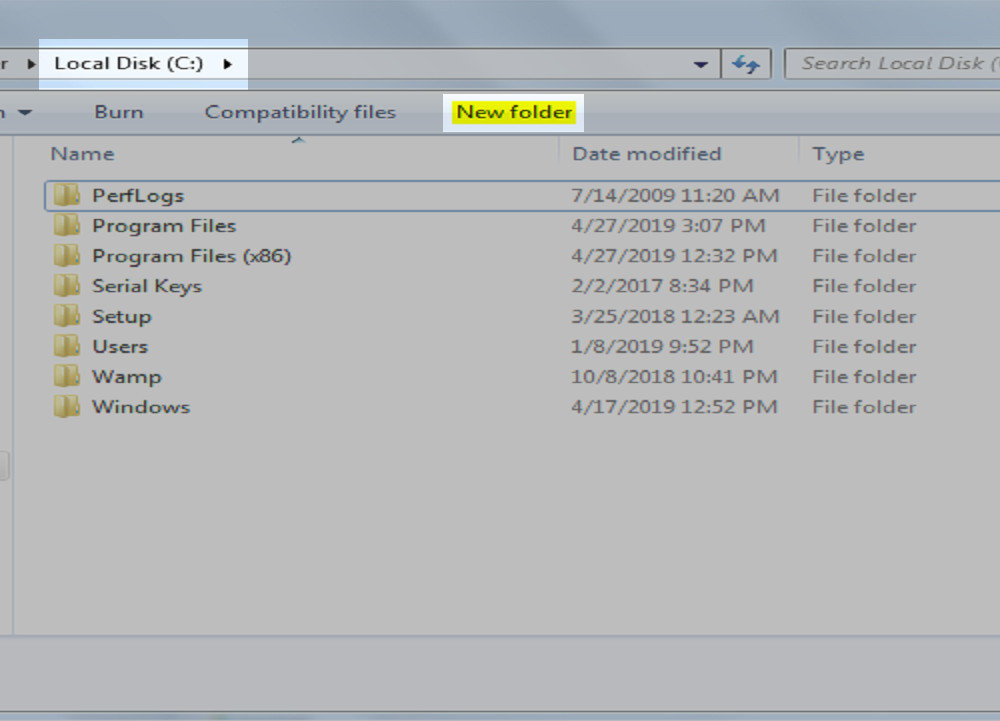
Here’s another way to create the data\db folder.
-
Use the command prompt
cdto get to the directory path. -
Open a new window. Use the command prompt
md. -
Next, create a folder and name it
data\db.
|
1 |
cd C:\some\absolute\path |
Use Hyper Terminal to Make mongod Alias Shortcuts
Git Bash is the default shell application to use to access the Hyper Terminal.
- Make the directory “”home”” in Hyper Terminal. Enter
cd~to do that.
- Check if you see the
.bash_profile. If it isn’t there, create one with the commandtouch. That’s the same as using the Windows command prompt and the commandnew file.
- The
vimeditor is what you’ll use to open the.bash_profile.
The .bash_profile will look similar to this as it is being edited using VIM Editor in Hyper Terminal.
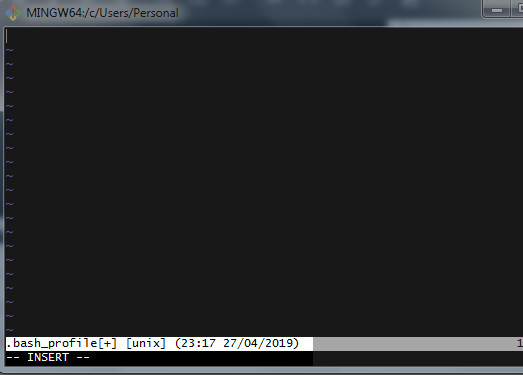
>NOTE: The .bash_profile is a hidden file. You can tell by the period that is placed at the start of the file name. To see all of a directory’s hidden files in a terminal that’s UNIX-based, use the command prompt ls -A.
-
Go to the
C:\Program Filesand locate the\MongoDB\Serverdirectory. You should see the recently installed MongoDB version identified by its version number. -
Right-click the folder to see the full path. Select “Copy” to copy it.
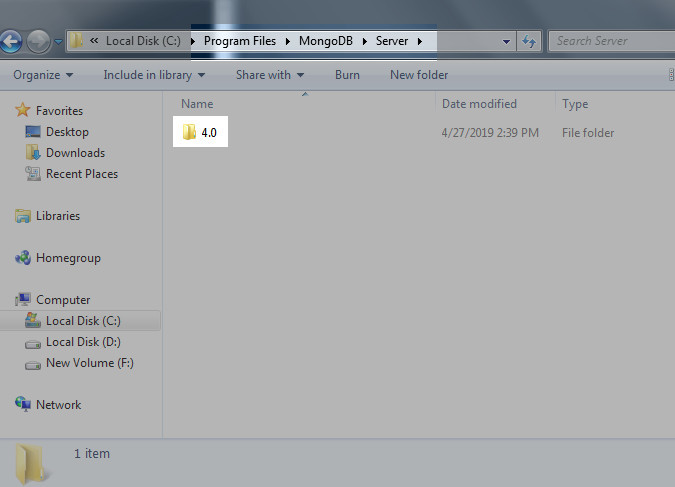
-
Go to the
.bash_profileagain in the Hyper Terminal and right-click and select “Paste” or do a CTRL+P to paste the MongoDB installation’s entire path in an instance of the.bash_profile. -
Within the string path, you’ll notice some character spaces. To get out of those, simply use a backslash (
\) and a space. See below.
|
1 |
alias mongod=«»/c/Program\ files/MongoDB/Server/4.0/bin/mongod.exe«» |
The finished process shows within the Hyper Terminal, the .bash_profile where the alias commands were pasted.
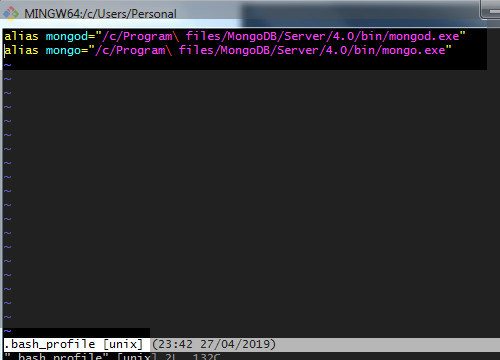
Time to Restart the MongoDB Service
You’ve successfully created the alias path, now it’s time to restart the service.
- You checked the version earlier, but let’s make sure it’s installed correctly on your OS. Go ahead and type
mongo --versionto restart Git Bash and check that everything went as planned.
MongoDB on Windows Git BASH Hyper Terminal shows the correct version installed on a local system.
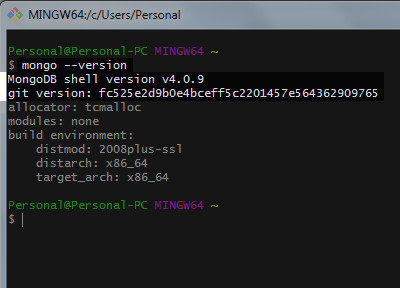
Conclusion
In this tutorial, you learned about installing MongoDB Windows. You used the Git BASH Hyper Terminal to put MongoDB successfully on your Windows server. During the process, you set up alias shortcuts and verified the correct version of MongoDB on your system. It’s important to configure things the right way, otherwise, it won’t work, not even a little bit. That will defeat the purpose. In addition, if you try different ways to install MongoDB and you repeatedly experience error messages, you’ve lost productivity. It could equate to lost time and labor, essentially money in working hours. Instead of guessing at it, try the method outlined in this tutorial. Next, be prepared to take advantage of the indexing and querying capability of MongoDB. Others have.
Pilot the ObjectRocket Platform Free!
Try Fully-Managed CockroachDB, Elasticsearch, MongoDB, PostgreSQL (Beta) or Redis.
Get Started
Данный материал предоставлен сайтом
PacificSky.Ru исключительно в ознакомительных целях. Администрация не несет ответственности за его содержимое.
Установка и запуск MongoDB на Windows 10.
В первую очередь необходимо
скачать MongoDB
с официального сайта.
После перехода по ссылке на официальный сайт перед вами будет представлена форма, в которой необходимо указать требуемую версию системы управления базами данных, вашу версию операционной системы, тип устанавливаемого пакета и нажать кнопку «Download» для скачивания.
После того как файл будет скачан, приступаем к установке:
Начиная с версии 4.0, MongoDB можно настроить и запустить как службу Windows в процессе установки.
Сама служба MongoDB будет запущена после успешной установки.
Для запуска MongoDB как службы в процессе установки необходимо отметить checkbox с пунктом: «Install MongoD as service».
Так-же вы можете установить MongoDB со своими параметрами или оставить все по умолчанию.
После выполнения установки MongoDB будет запущена как служба и будет доступна для работы с ней.
Если по каким то причинам вы не хотите запускать MongoDB как службу, то необходимо убрать галочку с «Install MongoD as service».
Запуск MongoDB из CMD консольного интерпретатора моманд.
- Создайте каталог данных, в котором MongoDB будет хранить данные.
По умолчанию это должен быть абсолютный путь — «C:\data\db».
Для этого создайте на диске «C» папку с названием «data» и внутри папки дата создайте папку «db«. - Для старта MongoDB необходимо запустить файл mongod.exe с указанием пути к базе данных.
Для этого запустить «cmd» консоль и выполните команду:"C:\Program Files\MongoDB\Server\4.2\bin\mongod.exe" --dbpath="c:\data\db".
- Для соединения с базой данных откройте еще одну «cmd» консоль и выполните команду:
"C:\Program Files\MongoDB\Server\4.2\bin\mongo.exe"
MongoDB is an open-source document-oriented database that is designed to store a large scale of data and also allows you to work with that data very efficiently. It is categorized under the NoSQL(Not only SQL) database because the storage and retrieval of data in MongoDB are not in the form of tables. This is the general introduction of MongoDB now we learn how to install MongoDB on your Windows?.
You can install MongoDB using two different methods one is using msi and another is using zip. Here, we will discuss how to install MongoDB using msi, so you need to follow each step carefully:
Step 1: Go to MongoDB Download Center to download MongoDB Community Server.
Here, You can select any version, Windows, and package according to your requirement. For Windows, we need to choose:
- Version: 4.2.2
- OS: WindowsOS
- Package: msi
Step 2: When the download is complete open the msi file and click the next button in the startup screen:
Step 3: Now accept the End-User License Agreement and click the next button:
Step 4: Now select the complete option to install all the program features. Here, if you can want to install only selected program features and want to select the location of the installation, then use the Custom option:
Step 5: Select “Run service as Network Service user” and copy the path of the data directory. Click Next:
Step 6: Click the Install button to start the installation process:
Step 7: After clicking on the install button installation of MongoDB begins:
Step 8: Now click the Finish button to complete the installation process:
Step 9: Now we go to the location where MongoDB installed in step 5 in your system and copy the bin path:
Step 10: Now, to create an environment variable open system properties << Environment Variable << System variable << path << Edit Environment variable and paste the copied link to your environment system and click Ok:
Step 11: After setting the environment variable, we will run the MongoDB server, i.e. mongod. So, open the command prompt and run the following command:
mongod
When you run this command you will get an error i.e. C:/data/db/ not found.
Step 12: Now, Open C drive and create a folder named “data” inside this folder create another folder named “db”. After creating these folders. Again open the command prompt and run the following command:
mongod
Now, this time the MongoDB server(i.e., mongod) will run successfully.
Run mongo Shell
Step 13: Now we are going to connect our server (mongod) with the mongo shell. So, keep that mongod window and open a new command prompt window and write mongo. Now, our mongo shell will successfully connect to the mongod.
Important Point: Please do not close the mongod window if you close this window your server will stop working and it will not able to connect with the mongo shell.
Now, you are ready to write queries in the mongo Shell.
Example:
Now you can make a new database, collections, and documents in your shell. Below is an example of how to make a new database:
The use Database_name command makes a new database in the system if it does not exist, if the database exists it uses that database:
use gfg
Now your database is ready of name gfg.
The db.Collection_name command makes a new collection in the gfg database and the insertOne() method inserts the document in the student collection:
db.student.insertOne({Akshay:500})
Last Updated :
28 Jun, 2022
Like Article
Save Article
In this MongoDB tutorial, I am listing down the steps to install MongoDB on Windows machine. Also, we will learn about a few basic operations related to starting and shutting down MongoDB.
1. Download MongoDB
There are three builds of MongoDB for Windows:
- MongoDB for Windows Server 2008 R2 edition [Download link]
- MongoDB for Windows 64-bit [Download link]
- MongoDB for Windows 32-bit [Download link]
To find which version of Windows you are running, enter the following command in the command prompt:
c:\> wmic os get osarchitectureMore download options are given in official website of MongoDB.
2. How to Install MongoDB
The links above will download zip files you extract directly onto any place in the system of your choice. I have extracted them in “d:/mongodb“. So, all code samples in this post and future posts will refer to this location.
It is recommended to add d:/mongodb/bin to Windows environment variable so that you can directly access MongoDB’s commands in the command prompt.
Also, please create the following directories inside d:/mongodb:
- D:\mongodb\data
- D:\mongodb\log
3. Create mongo.config Configuration File
This is an important step before marching ahead. Create a normal text file in location d:/mongodb and save it with the name mongo.config. Now place the below configuration options in the file. You can change the option’s values at your will.
##Which IP address(es) mongod should bind to.
bind_ip = 127.0.0.1
##Which port mongod should bind to.
port = 27017
##I set this to true, so that only critical events and errors are logged.
quiet = true
##store data here
dbpath=D:\mongodb\data
##The path to the log file to which mongod should write its log messages.
logpath=D:\mongodb\log\mongo.log
##I set this to true so that the log is not overwritten upon restart of mongod.
logappend = true
##log read and write operations
diaglog=3
##It ensures write durability and data consistency much as any journaling scheme would be expected to do.
##Only set this to false if you don’t really care about your data (or more so, the loss of it).
journal = true4. How to Start and Shutdown MongoDB Server
To start the MongoDB server, use the mongod command in the command prompt:
D:\mongodb\bin>mongod --config D:\mongodb\mongo.config --journal
2014-05-25T16:51:18.433+0530 warning: --diaglog is deprecated and will be removed in a future release
2014-05-25T16:51:18.434+0530 diagLogging level=3
2014-05-25T16:51:18.435+0530 diagLogging using file D:\mongodb\data/diaglog.5381d22eTo connect to MongoDB from the command prompt, use the mongo command:
D:\mongodb\bin>mongo
MongoDB shell version: 2.6.1
connecting to: test
Welcome to the MongoDB shell.
For interactive help, type "help".
For more comprehensive documentation, see https://www.mongodb.com/docs/
Questions? Try the support group https://groups.google.com/forum/!forum/mongodb-user
Server has startup warnings:
2014-05-25T16:52:09.158+0530 [initandlisten]
2014-05-25T16:52:09.158+0530 [initandlisten] ** NOTE: This is a 32 bit MongoDB binary.
2014-05-25T16:52:09.158+0530 [initandlisten] ** 32 bit builds are limited to less than 2GB of data (or less with --jour
nal).
2014-05-25T16:52:09.158+0530 [initandlisten] ** See https://www.mongodb.com/docs/manual/faq/fundamentals/
2014-05-25T16:52:09.158+0530 [initandlisten]To shutdown the MongoDB server, you must be an authorized user. So after getting auth complete, use the below command in the command prompt:
> use admin
switched to db admin
> db.shutdownServer()
2014-05-25T19:55:25.221+0530 DBClientCursor::init call() failed
server should be down...
2014-05-25T19:55:25.224+0530 trying reconnect to 127.0.0.1:27017 (127.0.0.1) failed
2014-05-25T19:55:26.225+0530 warning: Failed to connect to 127.0.0.1:27017, reason: errno:10061 No connection could be made b
ecause the target machine actively refused it.
2014-05-25T19:55:26.225+0530 reconnect 127.0.0.1:27017 (127.0.0.1) failed failed couldn't connect to server 127.0.0.1:27017 (
127.0.0.1), connection attempt failed
> quit()5. How to Install MongoDB Windows Service
To install the window service, use the below command:
mongod --config D:\mongodb\mongo.config --installStart the windows service from the command prompt:
net start MongoDBStop the windows service from the command prompt:
net stop MongoDBRemove the windows service:
mongod --removeSample run of all above four commands is below:
D:\mongodb\bin>mongod --config D:\mongodb\mongo.config --install
2014-05-25T20:07:41.191+0530 warning: --diaglog is deprecated and will be removed in a future release
2014-05-25T20:07:41.192+0530 diagLogging level=3
2014-05-25T20:07:41.193+0530 diagLogging using file D:\mongodb\data/diaglog.53820035
D:\mongodb\bin>net start MongoDB
The MongoDB service was started successfully.
D:\mongodb\bin>net stop MongoDB
System error 109 has occurred.
The pipe has been ended.
D:\mongodb\bin>mongod --remove
2014-05-25T20:09:32.514+0530
2014-05-25T20:09:32.515+0530 warning: 32-bit servers don't have journaling enabled by default. Please use --journal if you wa
nt durability.
2014-05-25T20:09:32.515+0530
2014-05-25T20:09:32.518+0530 Trying to remove Windows service 'MongoDB'
2014-05-25T20:09:32.520+0530 Service 'MongoDB' removed6. Download/Use MongoDB Java Driver
Download the MongoDB java driver (mongo-java-driver-2.9.3.jar) from this download link. It’s a jar file you need to include in your classpath or copy in /lib folder in the project where you want to use MongoDB.
7. Verify MongoDB Connection from Java Application
To verify that MongoDB has been installed and working properly, execute the below program:
import java.net.UnknownHostException;
import java.util.List;
import com.mongodb.MongoClient;
public class VerifyMongoDBInstallation {
public static void main(String[] args) throws UnknownHostException {
MongoClient mongo = new MongoClient("localhost", 27017);
List<String> dbs = mongo.getDatabaseNames();
for (String db : dbs) {
System.out.println(db);
}
}
}That’s all for MongoDB windows installation, startup and shutdown operations. Next, we will learn about some CRUD operations. Follow me to stay tuned.
Happy Learning !!



